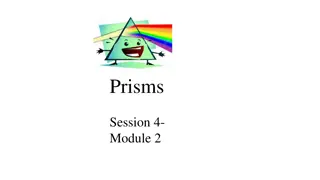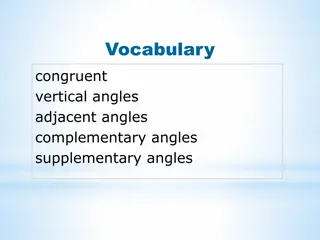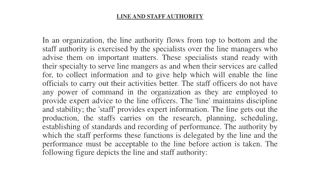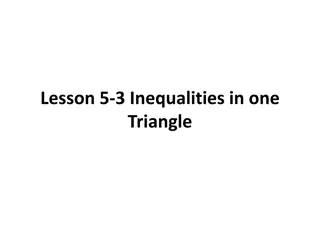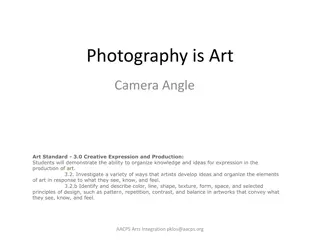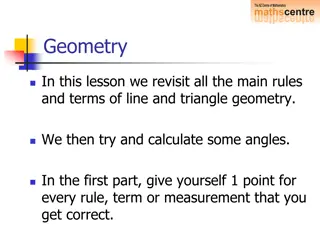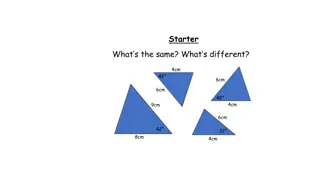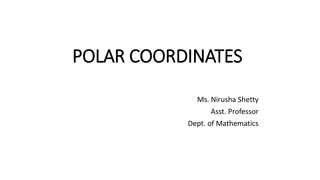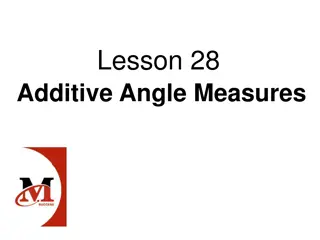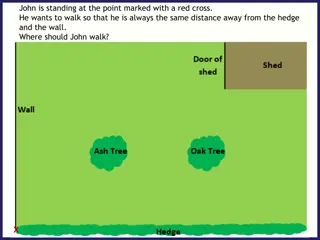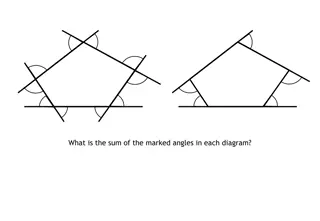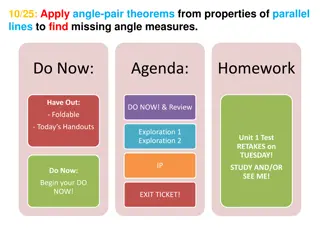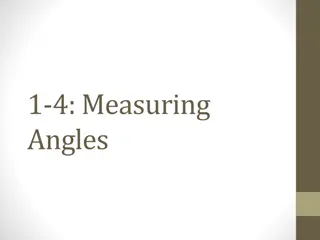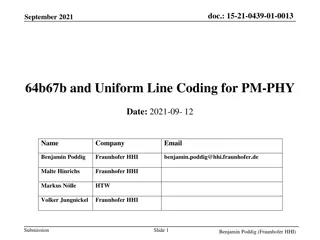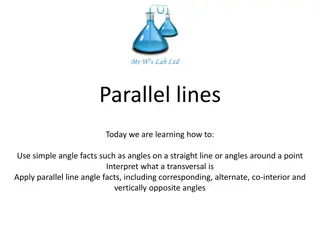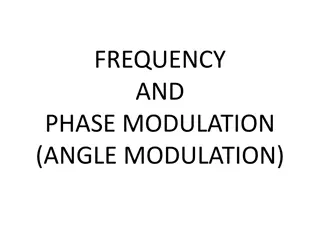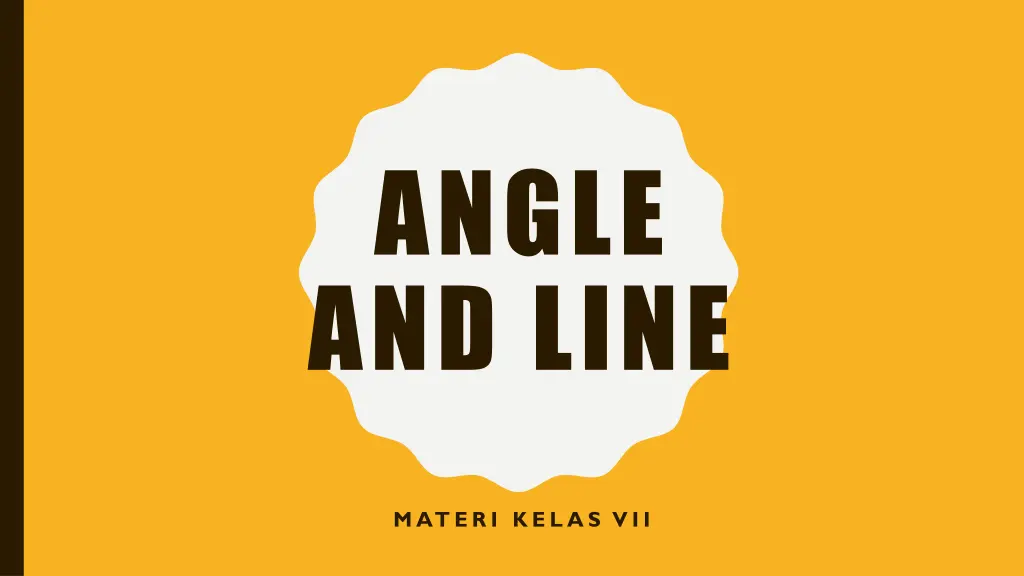
Understanding Angle and Line Relationships
Explore the concepts of angles and lines in mathematics, including parallel lines, intersecting lines, types of angles, complementary and supplementary angles, vertical angles, and angles formed when parallel lines are intersected. Visual aids and explanations provided to enhance understanding.
Download Presentation

Please find below an Image/Link to download the presentation.
The content on the website is provided AS IS for your information and personal use only. It may not be sold, licensed, or shared on other websites without obtaining consent from the author. If you encounter any issues during the download, it is possible that the publisher has removed the file from their server.
You are allowed to download the files provided on this website for personal or commercial use, subject to the condition that they are used lawfully. All files are the property of their respective owners.
The content on the website is provided AS IS for your information and personal use only. It may not be sold, licensed, or shared on other websites without obtaining consent from the author.
E N D
Presentation Transcript
ANGLE AND LINE MATERI KELAS VII
LINE PARALLEL LINES AND INTERSECTING LINES Parallel lines or garis sejajar is lines on a plane that never meet. They are always the same distance apart. One point intersection Intersecting lines, if lines just have one point intersection.
LINES THE RELATIONSHIPS OF TWO LINES Coincident lines are lines which lie on one straight line such that we perceive only a single line instead of many lines. For example : when the time is 12 o clock, hours hand and minutes hand coincide Two intersecting lines can t be located at the same sides and they are not parallel lines.
ANGLE angle
TYPES OF ANGLES Right angle is An angle which is equal to 90 . Acute angle is An angle less than 90 (0 < D < 90 ). Obtuse angle is more than 90 but less than 180 (90 < D < 180 ). Straight angle is an angle is equal to 180 . Reflex angle is more than 180 but less than 360 (180 < D < 360 ).
ANGLES RELATIONSHIP COMPLEMENTARY ANGLES (SUDUT BERPENYIKU) or x+y = 90 D x y
ANGLE RELATIONSHIP SUPPLEMENTARY ANGLES (SUDUT BERPELURUS) or x+y+z = 180 y x z
OPPOSITE OR VERTICAL ANGLES (SUDUT BERTOLAK BELAKANG) The angles A1 and A3whose rays form two intersecting straight lines are called a pair of opposite or vertical angles. Angles which are opposite to each other are equal in measure.
ANGLE RELATIONSHIP ANGLES FORMED WHEN TWO PARALLEL LINES ARE INTERSECTED BY ANGLES FORMED WHEN TWO PARALLEL LINES ARE INTERSECTED BY ANOTHER LINE ANOTHER LINE Before we begin this topic, lets see this video https://www.youtube.com/watch?v=hJFxXrUQqUM
CORRESPONDING ANGLES (SUDUT SEHADAP) Look at the figure. A2 and B2are facing in the same direction. Angles such as A2 and B2 are called corresponding angles. A1 = B1 A2 = B2 A3 = B3 A4 = B4
ALTERNATE INTERIOR ANGLES (SUDUT DALAM BERSEBERANGAN) Look at the figure. A3 and B1are on opposite sides of the line g and inside the lines l and m Angles such as A3 and B1are called alternate interior angles. Other alternate interior angles are A4 and B2 A3 = B1 A4 = B2
ALTERNATE EXTERIOR ANGLES (SUDUT LUAR BERSEBERANGAN) Look at the figure. A1 and B3are on opposite sides of the line g and outside the lines l and m. Angles like A1 and B3are called alternate exterior angles. Other alternate exterior angles are A2 and B4 A1 = B3 A2 = B4
CONSECUTIVE INTERIOR ANGLES (SUDUT DALAM SEPIHAK) Look at the figure. A3 and B2are on the same sides (on the right) of the line g and inside the lines l and m. Angles such as A3 and B3are called consecutive interior angles. Other consecutive interior angles are A4 and B1 A3 + B2 = 180 A4 + B1 = 180
CONSECUTIVE EXTERIOR ANGLES (SUDUT LUAR SEPIHAK) Look at the figure. A1 and B4are on the same sides (on the left) of the line g and outside the lines l and m. Angles such as A1 and B4are called consecutive exterior angles. Other consecutive exterior angles are A2 and B3 A1 + B4 = 180 A2 + B3 = 180
EXAMPLE NO. 1 Find angle of ABD. Answer. ABD and CBD are supplementary angles then, (2x + 10) + (x + 8) = 180 2x + x + 10 + 8 = 180 3x + 18 = 180 3x = 180 - 18 3x = 162 x = 54 ABD = (2x + 10) , then : ABD = 2(54 ) + 10 = 108 + 10 = 118
EXAMPLE NO. 2 Find value of x Answer. First step, we must find the value of PRQ : PRQ + QRS = 180 PRQ + 110 = 180 PRQ = 180 - 110 = 70 After that, find the value of x in the PRQ triangle Sum of all angles in a triangle is = 180 . Then : QPR + PQR + PRQ = 180 x + x + 2 + 70 = 180 2x + 72 = 180 2x = 180 - 72 2x = 108 x = 54 QPR = x = 54
EXAMPLE NO. 3 If P = 125 , find the other seven angles. answer: R = P = 125 (R opposite P) T = P = 125 (T and P are corresponding angles) V = R = 125 (V and R are corresponding angles) Q = 180 P = 180 125 = 55 (Q supplementary angle of P) S = Q = 55 (S opposite Q) U = Q = 55 (U and Q are corresponding angles) W = U = 55 (W opposite U)
EXAMPLE NO. 4 p line is parallel with q line. Find angle of A and B. Answer: A and B are alternate interior angles, then : 5x 10 = 3x + 20 2x = 30 x = 15 A = 3x + 20 = 3(15) + 20 = 65 B = 5x 10 = 5(15) 10 = 65
FINISH let's do the exercise


